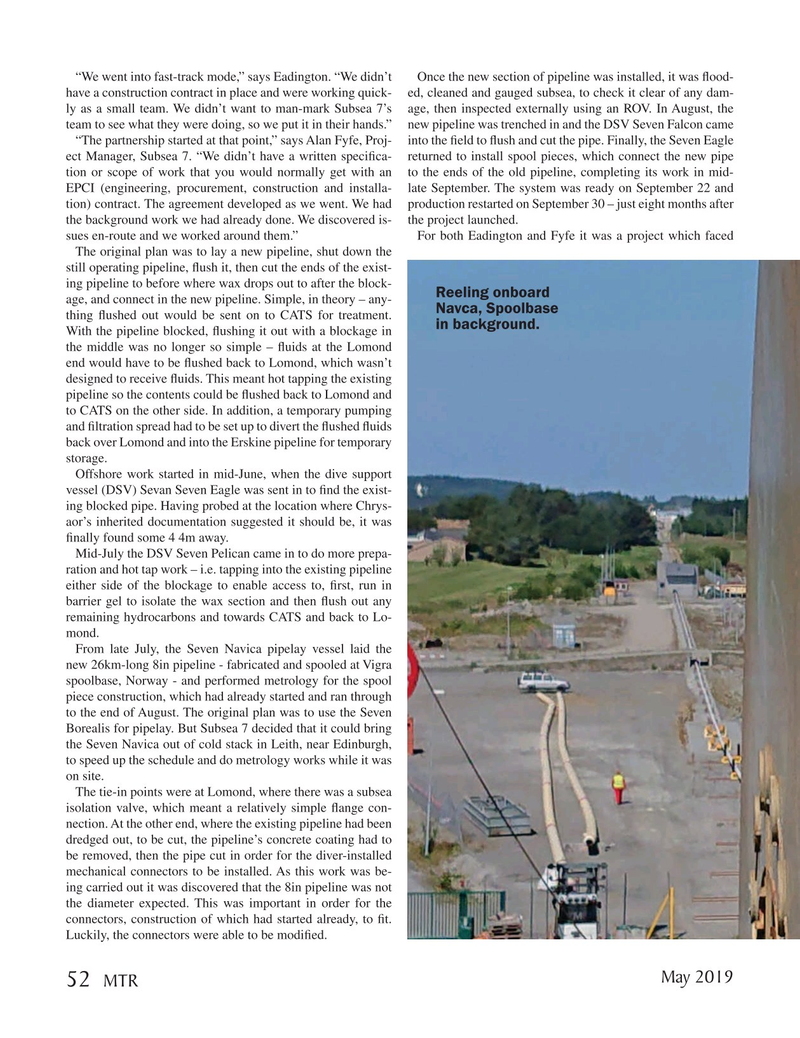
Page 52: of Marine Technology Magazine (May 2019)
Underwater Defense Technology
Read this page in Pdf, Flash or Html5 edition of May 2019 Marine Technology Magazine
“We went into fast-track mode,” says Eadington. “We didn’t Once the new section of pipeline was installed, it was ? ood- have a construction contract in place and were working quick- ed, cleaned and gauged subsea, to check it clear of any dam- ly as a small team. We didn’t want to man-mark Subsea 7’s age, then inspected externally using an ROV. In August, the team to see what they were doing, so we put it in their hands.” new pipeline was trenched in and the DSV Seven Falcon came “The partnership started at that point,” says Alan Fyfe, Proj- into the ? eld to ? ush and cut the pipe. Finally, the Seven Eagle ect Manager, Subsea 7. “We didn’t have a written speci? ca- returned to install spool pieces, which connect the new pipe tion or scope of work that you would normally get with an to the ends of the old pipeline, completing its work in mid-
EPCI (engineering, procurement, construction and installa- late September. The system was ready on September 22 and tion) contract. The agreement developed as we went. We had production restarted on September 30 – just eight months after the background work we had already done. We discovered is- the project launched. sues en-route and we worked around them.” For both Eadington and Fyfe it was a project which faced
The original plan was to lay a new pipeline, shut down the still operating pipeline, ? ush it, then cut the ends of the exist- ing pipeline to before where wax drops out to after the block-
Reeling onboard age, and connect in the new pipeline. Simple, in theory – any-
Navca, Spoolbase thing ? ushed out would be sent on to CATS for treatment. in background.
With the pipeline blocked, ? ushing it out with a blockage in the middle was no longer so simple – ? uids at the Lomond end would have to be ? ushed back to Lomond, which wasn’t designed to receive ? uids. This meant hot tapping the existing pipeline so the contents could be ? ushed back to Lomond and to CATS on the other side. In addition, a temporary pumping and ? ltration spread had to be set up to divert the ? ushed ? uids back over Lomond and into the Erskine pipeline for temporary storage.
Offshore work started in mid-June, when the dive support vessel (DSV) Sevan Seven Eagle was sent in to ? nd the exist- ing blocked pipe. Having probed at the location where Chrys- aor’s inherited documentation suggested it should be, it was ? nally found some 4 4m away.
Mid-July the DSV Seven Pelican came in to do more prepa- ration and hot tap work – i.e. tapping into the existing pipeline either side of the blockage to enable access to, ? rst, run in barrier gel to isolate the wax section and then ? ush out any remaining hydrocarbons and towards CATS and back to Lo- mond.
From late July, the Seven Navica pipelay vessel laid the new 26km-long 8in pipeline - fabricated and spooled at Vigra spoolbase, Norway - and performed metrology for the spool piece construction, which had already started and ran through to the end of August. The original plan was to use the Seven
Borealis for pipelay. But Subsea 7 decided that it could bring the Seven Navica out of cold stack in Leith, near Edinburgh, to speed up the schedule and do metrology works while it was on site.
The tie-in points were at Lomond, where there was a subsea isolation valve, which meant a relatively simple ? ange con- nection. At the other end, where the existing pipeline had been dredged out, to be cut, the pipeline’s concrete coating had to be removed, then the pipe cut in order for the diver-installed mechanical connectors to be installed. As this work was be- ing carried out it was discovered that the 8in pipeline was not the diameter expected. This was important in order for the connectors, construction of which had started already, to ? t.
Luckily, the connectors were able to be modi? ed.
May 2019 52
MTR
MTR #4 (50-63).indd 52 4/26/2019 10:00:15 AM

 51
51

 53
53
